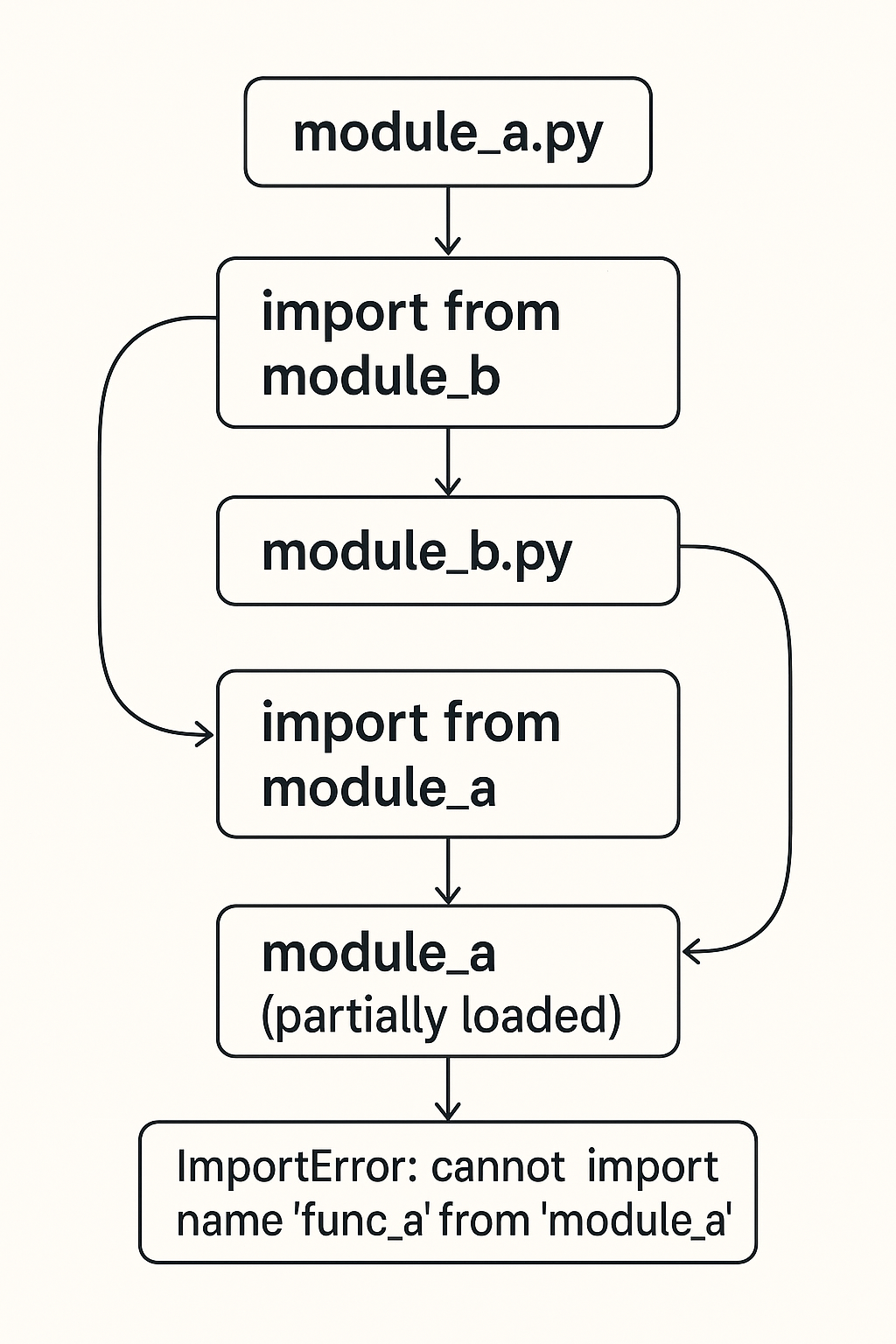Course
Python’s import system is designed to be simple and intuitive. In most cases, you can organize your code across multiple files and bring everything together using straightforward import statements.
However, when modules start depending on each other, you might run into a frustrating issue: the circular import. These errors often show up unexpectedly, with confusing messages like:
ImportError: cannot import name 'X' from 'Y' (most likely due to a circular import)In this article, we’ll explore what circular imports are, why they happen, and how to resolve them using simple, effective strategies. We’ll also look at how to design your code to avoid them altogether which will make your projects more robust, maintainable, and easier to understand.
What Is a Circular Import in Python?
A circular import occurs when two or more Python modules depend on each other, directly or indirectly. When Python tries to import these modules, it ends up stuck in a loop and fails to complete the import process.
Here’s a simple example involving two modules:
# file: module_a.py
from module_b import func_b
def func_a():
print("Function A")
func_b()# file: module_b.py
from module_a import func_a
def func_b():
print("Function B")
func_a()Running either of these files will produce the following error:
ImportError: cannot import name 'func_a' from 'module_a' (most likely due to a circular import)What’s happening here? Python starts by loading module_a, which imports module_b. But then module_b tries to import module_a again, which is before func_a has been defined. Since Python only initializes each module once, it ends up working with a partially loaded version of module_a, and the import fails.
To understand it better, think of the import flow like this:
 Circular import flow in Python. Image by Author.
Circular import flow in Python. Image by Author.
This creates a dependency cycle. Since Python doesn't reload modules that are already in the process of being imported, it encounters missing definitions and throws an error.
Typical error messages
Here are some common messages that signal a circular import issue:
-
ImportError: cannot import name 'X' from 'Y' -
AttributeError: partially initialized module 'X' has no attribute 'Y'
These errors can be especially confusing because they often appear deep in the call stack, not at the line of code where the actual problem started.
Why Circular Imports Happen
Circular imports usually aren’t intentional. They are a side effect of how modules are structured and how functions, classes, or constants are shared between them. Understanding the root causes can help you fix existing issues and avoid creating new ones as your codebase grows.
Common causes of circular imports
Several design patterns and project structures can accidentally create circular dependencies. Here are some of the most common scenarios:
Mutual dependencies between modules
Two modules import each other to access functionality. For example, utils.py calls a function in core.py, and core.py also imports something from utils.py. Neither can fully load without the other.
Top-level imports that fire too early
If a class or function is imported at the top level (i.e., outside of a function or method), it’s executed as soon as the module is imported. This can cause trouble if that top-level import triggers a circular reference.
Classes that depend on each other
It’s common in object-oriented design for one class to need another. For example, a User class that uses a Profile class, and vice versa. If both are in separate modules and imported at the top level, a circular import will occur.
Poorly defined module boundaries
As projects grow, code can become tightly coupled across modules. If responsibilities aren’t clearly separated, it’s easy to fall into a tangle of interdependent imports.
Implicit imports from frameworks or plugins
Sometimes circular imports happen through external libraries, especially if you're using frameworks with plugins or auto-discovery features. These can trigger imports indirectly and cause circular issues that are harder to trace.
Real-world example: physics.py and entities/post.py
Let’s say you’re building a basic game engine. You have two modules:
physics.pyhandles gravity and collision logic.entities/post.pydefines player and enemy classes, which use functions fromphysics.py.
Here’s what the code might look like:
# file: entities/post.py
from physics import apply_gravity # Top-level import
class Player:
def __init__(self, mass):
self.mass = mass
def update(self):
apply_gravity(self)# file: physics.py
from entities.post import Player # Top-level import creates circular dependency
def apply_gravity(entity):
if isinstance(entity, Player):
print(f"Applying gravity to player with mass {entity.mass}")Now, if you try to import Player or run the game logic, you’ll get the following error:
Traceback (most recent call last):
File "entities/post.py", line 1, in <module>
from physics import apply_gravity
File "physics.py", line 1, in <module>
from entities.post import Player
ImportError: cannot import name 'Player' from 'entities.post' (most likely due to a circular import)Here’s what’s happening:
-
entities/post.pyis imported first and tries to loadapply_gravity()fromphysics.py. -
physics.pystarts loading and tries to import thePlayerclass fromentities/post.py. -
But
Playerhasn’t been defined yet, and Python is still working onentities/post.py!
This creates a circular loop where each file is waiting on the other to finish loading. Python ends up with a partially initialized module and throws an ImportError.
This kind of indirect circular dependency is common in larger projects where logic is split across modules. Fortunately, as we’ll see next, there are several ways to resolve and avoid this.
Issues Caused by Circular Imports
Circular imports don’t just cause import errors, they can affect your code in ways that are harder to detect. From confusing error messages to long-term architectural problems, here’s what you might run into if circular dependencies are left unchecked.
ImportErrors and AttributeErrors
The most immediate effect of a circular import is an error during module loading. These usually take one of two forms:
-
ImportError: cannot import name 'X' from 'Y': Python tries to access a name that hasn’t been defined yet because the module didn’t finish loading. -
AttributeError: partially initialized module 'X' has no attribute 'Y': Python imported the module, but the function or class you’re trying to use doesn’t exist yet because of the import loop.
These errors can be frustrating because they often point to the symptom (e.g., a missing function) rather than the cause (the circular import).
Hard-to-debug dependencies
Circular imports often create invisible chains of dependency across your codebase. A bug in one module might appear to originate in another, making debugging much harder. You might spend time looking at the wrong file, unaware that the issue is caused by a circular reference several layers deep.
This is especially problematic in large applications where one small import at the top of a file can trigger a cascade of problems.
Poor code readability and maintainability
Circular imports are usually a sign that modules are doing too much or are too tightly coupled. When files depend on each other in a loop, it becomes harder to understand where logic lives and how different parts of your code interact.
Over time, this makes the code harder to maintain. New team members (or future you) may have to spend extra time unraveling the web of interdependencies before making any changes.
Potential performance bottlenecks
In some cases, developers try to “solve” circular imports with dynamic or repeated imports using techniques like importlib or local imports inside functions. While these can work, they can also create small performance penalties due to repeated resolution or delayed loading at runtime especially if done frequently inside tight loops or large-scale applications.
An architectural red flag
Most importantly, circular imports often signal a deeper design problem. They suggest that your code lacks a clear separation of concerns. Modules that rely on each other too heavily are harder to test, harder to scale, and harder to refactor. In other words, circular imports aren’t just bugs, they’re code smells.
In the next section, we’ll look at how to fix circular imports using practical strategies like local imports, refactoring, and dynamic loading. These fixes not only stop the errors, they also help you clean up your architecture.To summarize the practical effects of circular imports and why they’re more than just an annoyance, here’s a quick breakdown of the key issues they cause:
|
Issue |
Description |
|
ImportError / AttributeError |
Python cannot complete the import because the module is only partially loaded. This often results in cryptic error messages. |
|
Difficult Debugging |
Errors often appear far from the actual problem, making root cause analysis tricky, especially in large codebases. |
|
Poor Maintainability |
Circular dependencies make it harder to refactor or extend code. Modules become tightly coupled and harder to understand. |
|
Performance Overhead |
Workarounds like dynamic imports or lazy loading can introduce small but unnecessary runtime delays. |
|
Architectural Smell |
Circular imports suggest a lack of separation of concerns and poor project structure, making the entire system more fragile. |
Recognizing these symptoms is the first step. Next, let’s explore how to resolve circular imports using strategies that improve both functionality and code structure.
How to Fix Circular Imports
Once you’ve identified a circular import in your code, the good news is that there are several effective ways to resolve it. Let’s walk through the most reliable techniques.
Refactor your modules
Often, circular imports happen because modules are doing too much or are too tightly connected. One of the cleanest fixes is to reorganize your code by:
-
Moving shared functionality to a third file (e.g.,
common.py,utils.py, orbase.py) -
Merging two interdependent modules into one, if they are logically part of the same unit.
Let’s look at an example on extracting shared logic:
# file: common.py
def apply_gravity(entity):
print("Gravity applied to", entity)
# file: physics.py
from common import apply_gravity
# file: entities/post.py
from common import apply_gravityBy moving apply_gravity() into common.py, both physics.py and entities/post.py can import it without depending on each other.
Use local or lazy imports
Instead of importing at the top of a file, place the import inside the function or method that actually uses it. This delays the import until the function is called, after all modules have finished loading. Here’s an example of lazy import inside a method:
# file: physics.py
def apply_gravity(entity):
from entities.post import Player # Local import
if isinstance(entity, Player):
print("Applying gravity")This works well when the import is only needed in specific situations. Just be sure to add a comment explaining why the import is placed there.
Use 'import module' instead of 'from module import …'
Using import module defers name resolution until runtime, which can help avoid early lookups that trigger circular imports.The code below is an example of direct import that causes early lookup:
from physics import apply_gravity # May cause a circular importA more suitable approach is using the deferred attribute access:
import physics
def update():
physics.apply_gravity()This method is simple and effective in many cases, especially when you just need to access a function or class occasionally.
Move imports to the bottom
In some scenarios, simply placing the import statement at the bottom of the file, after class/function definitions, can solve the issue. Here’s a good example:
# file: module_a.py
def func_a():
print("Function A")
from module_b import func_b # Import after definitionsThis only works if the imported name isn’t required during the module’s initialization, so use it carefully.
Use importlib for dynamic imports
Python’s built-in importlib module lets you load modules programmatically. This is especially useful for optional plugins or runtime logic where imports should be deferred.
Here’s an example using importlib.import_module
import importlib
def get_player_class():
entities = importlib.import_module("entities.post")
return entities.PlayerThis method avoids top-level imports altogether and keeps dependencies flexible. It’s a great choice for plugin systems, extensions, or dynamic routing logic.
With several strategies to choose from, it helps to compare them side by side. Here’s a quick reference to help you decide which fix fits your situation best:
|
Fix |
When to Use It |
How It Helps |
Example |
|
Refactor your modules |
When two modules depend on shared logic |
Moves shared code to a neutral location, breaking the loop |
Extract to |
|
Use local/lazy imports |
When the import is only needed inside a function or method |
Delays import until runtime, after all modules have loaded |
|
|
Use |
When you need to access a few functions or classes |
Defers name resolution, avoiding premature access |
import |
|
Move imports to the bottom |
When imported names aren’t needed during initialization |
Allows the module to fully define itself before importing |
Place |
|
Use |
When working with optional modules, plugins, or runtime logic |
Gives you full control over when and how a module is imported |
|
How to Prevent Circular Imports
Fixing circular imports is useful, but preventing them altogether is even better. A well-organized codebase with clearly defined boundaries between modules is much less likely to run into these issues.
Here are some proven ways to avoid circular imports in Python projects.
Plan your module architecture early
Circular imports often arise from poor project structure. Avoid this by planning your module layout before diving into implementation. Here are some questions you should ask:
- Does each module have a single, clear responsibility?
- Are you separating logic by concern (e.g., models, services, utilities)?
- Can certain modules be combined or abstracted?
Use a top-down approach or visual tool to sketch how modules should interact before you start coding.
Apply architectural patterns
Patterns like model-view-controller (MVC) or layered architecture naturally prevent circular imports by enforcing a hierarchy of dependencies.
- Controllers can depend on models, but not vice versa.
- Views depend on controllers, but don’t import business logic directly.
This top-down flow keeps your dependencies clean and one-directional.
Avoid importing implementation details
Try to import only what a module exposes publicly, not its internal helpers or classes. For example, instead of importing a class deep within another module, expose a clean API at the top level of that module.
# Good
from auth import authenticate_user # Clean interface
# Risky
from auth.utils.token_handler import generate_token # Fragile and tightly coupledThis practice makes your modules easier to refactor without creating hidden dependencies.
Be mindful with relative imports
While relative imports (from .module import X) can make code cleaner, they can also increase the chance of circular references in deeply nested packages.
Use them sparingly and only when they clearly improve readability. In large applications, prefer absolute imports with well-defined module paths.
Use dependency injection
If two modules rely on shared functionality, consider injecting the dependency instead of importing it. Here’s an example:
# Instead of importing directly
def run_simulation():
from physics import apply_gravity
apply_gravity()
# Use dependency injection
def run_simulation(apply_gravity_fn):
apply_gravity_fn()This keeps your modules loosely coupled and makes unit testing easier too.
Visualize your import graph
Use tools to inspect and visualize how modules depend on each other:
-
pydeps: Generates dependency graphs of your project.
-
snakeviz: Visualizes runtime profiling (useful if lazy imports affect performance). -
pipdeptree: Inspects third-party package dependencies.
Regularly reviewing these graphs can help catch circular imports before they cause real problems.
Use code reviews as a safety net
Finally, make import structure part of your code review checklist. Catching architectural issues early is much easier than debugging broken imports later. A quick look at the import tree can save hours of frustration down the road.
Conclusion
Circular imports are one of those Python pitfalls that seem mysterious at first, but once you understand what’s going on behind the scenes, they become much easier to diagnose and fix.
At their core, circular imports are a side effect of how modules are structured and how they interact. They tend to appear in growing projects when logic becomes tightly coupled or responsibilities blur across files. But they also serve as a helpful signal, an opportunity to step back, reevaluate your architecture, and simplify your codebase.
If you’re looking to sharpen your Python skills even further, check out Writing Efficient Python Code to learn more about designing maintainable code. You can also build a strong foundation with our Introduction to Python course, or dive deeper into modular design with Object-Oriented Programming in Python - these are all great options.
Experienced data professional and writer who is passionate about empowering aspiring experts in the data space.
FAQs
What causes circular imports in Python?
Circular imports happen when two or more modules depend on each other, creating a loop that prevents Python from fully loading either module.
How can I detect circular imports early?
Look for mutual imports between files or use tools like pydeps to visualize your project’s import graph.
What's the quickest way to fix a circular import?
Refactoring shared logic into a separate module or using a local import inside a function are often the fastest solutions.
Is it bad to use importlib to fix circular imports?
It's okay for dynamic or optional imports, but it's better to restructure your code to avoid circular dependencies altogether for long-term maintainability.
How can I prevent circular imports in my project?
Plan your module structure early, follow clear separation of concerns, and use dependency injection or service layers when modules need to interact.


